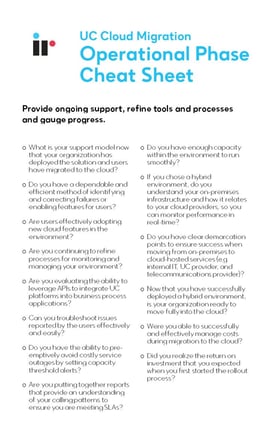This is the fourth blog post in the series where we take a comprehensive look at transitioning your unified communications to the cloud. Last time, we looked at the key areas to consider when it is time to deploy your unified comms to the cloud. To conclude the series, let's delve into the operation and optimization phase where your organization will provide ongoing support, refine tools and processes and gauge the progress of your solution.

Ongoing Support and Monitoring Unified Comms in the Cloud
When people experience failures or need additional features to be enabled, the operation phase is where you will use tools and processes that carry forward from your deployment phase. If you have already installed effective unified comms monitoring and manageability like IR Prognosis, this is where you will see those resources become more mature. Now that you have moved users to the cloud, you should construct a clear support model moving forward.
Real-time UC Monitoring Helps Meet SLAs
By maintaining ongoing monitoring and visibility during operation, you will be able to determine if you are reaching capacity limitations. If you chose to build a hybrid environment, ongoing monitoring will allow you to gain a complete picture of calling patterns, manage on-premise equipment effectively, and obtain information about the user experience from your cloud providers. Real-time monitoring and reporting is the key to delivering on your internal SLAs and expectations.
Evaluate Cloud Unified Comms Adoption
During this phase, you can evaluate your cloud UC adoption and determine if users are adopting the features within your environment. By running reports, you will be able to demonstrate to executive stakeholders that you were successful at migrating to the cloud while managing costs effectively. The information from these reports will show whether or not you realized the return on investment that you expected when you first started the rollout. If you performed partial migration with a hybrid solution, reporting on your success may drive the business case for adopting a full cloud UC solution.
Establish Demarcation Points
One of the key challenges you will face as an organization moving to cloud telephony is understanding the different areas of responsibility where issues can potentially occur. You no longer have just the internal IT organization to consider. Now you also have the cloud unified communications provider and telecommunications provider that supplies your network link to the cloud. Understanding the demarcation points is critical to ensure success.
End-to-end Visibility Crucial for Optimization
To help make the process easier, retain end-to-end visibility from the end user experience to the cloud. It would also be a good idea to build solid partnerships with many of the service providers, telcos, and your system integrators. These relationships will be helpful for continued optimization advice.




